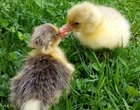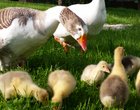Geese.ch
West of England Gänse
Characteristics
West of England geese are a rare or heritage breed of geese, originally found across the south of England, Devon and Cornwall. They are medium-sized geese that are auto-sexing - i.e. you can tell females from males by their grey markings on head and back from the moment of hatch. This is a great advantage, because sexing geese is notoriously difficult.
West of Englands have blue eyes, an orange bill and a dual-lobed paunch. They weigh between 6 and 9 kg. The gander is white, sometimes with some traces of grey. The goose has clear grey markings on head, neck, back and the thigh coverts. West of England geese are quite calm in temperament and become friendly towards people given enough contact with humans.
In spring the female lays up to 40 eggs of 130- 200g in weight. If she collects a clutch, she may sit on the nest and will usually achieve a much higher hatch rate than an incubator. However, geese in their first adult spring may have insufficient energy reserves for this one-month deprivation and should not be allowed to incubate.
Breed standards exist from the British Waterfowl Association and the Poultry Club of Great Britain.
Here is our presentation on what judges should be looking for in this breed when judging them in a bird show.
If you have or are interested in West of England geese, you can also join the active West of England Facebook community.




